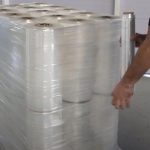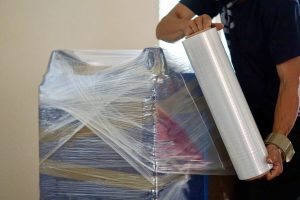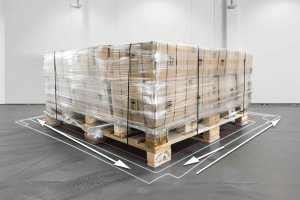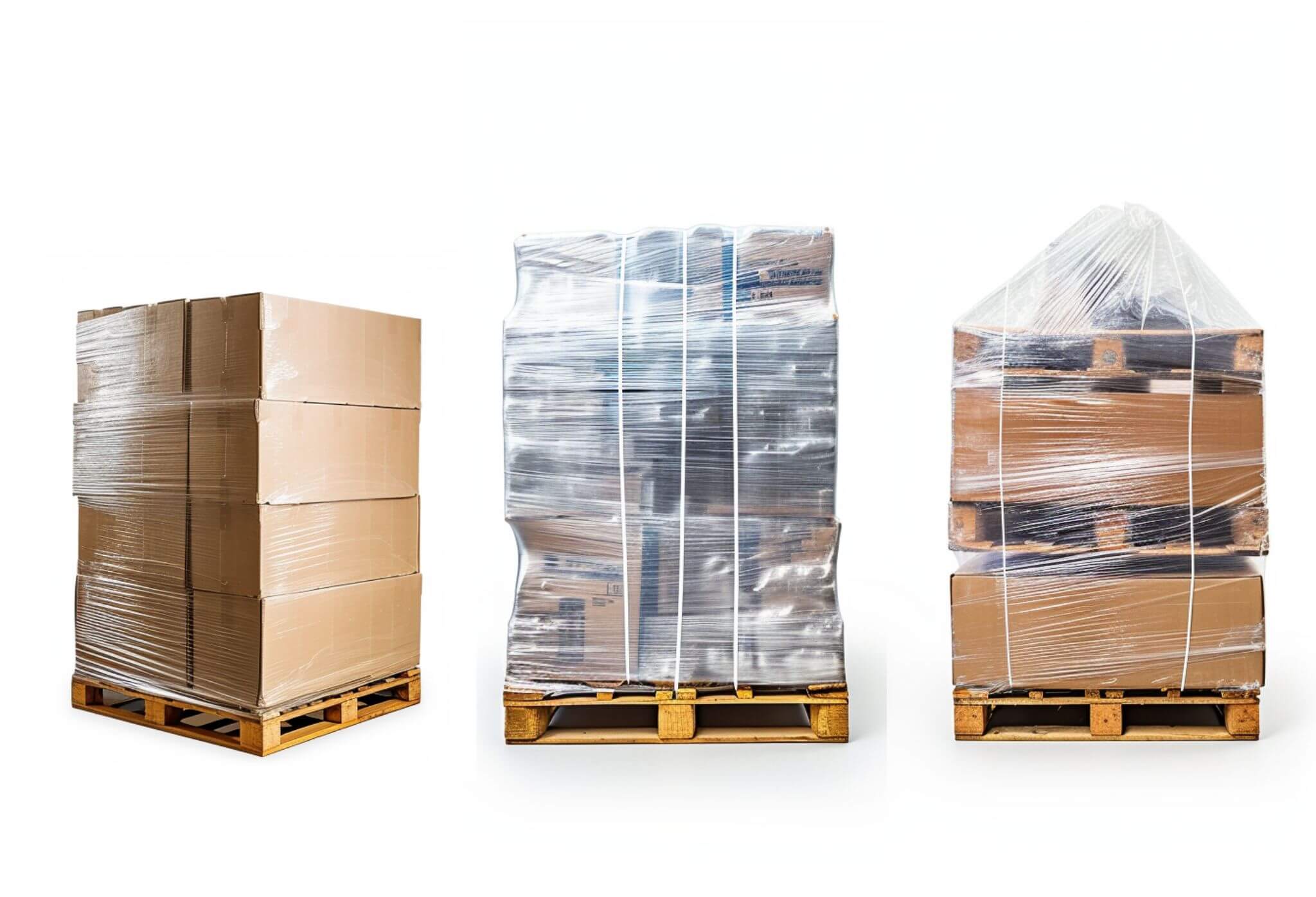
In industrial packaging, the choice of film can significantly impact the effectiveness of palletized loads. The packaging industry offers a variety of films, each with its own application, advantages, and unique properties. In this article, we will explore the characteristics of three of the most commonly used films: Stretch Film, Shrink Wrap, and Stretch Hood.
Stretch Film
Stretch film is a versatile pallet packaging solution utilized by Stretch Wrapping machines, both semi-automatic and automatic. The film stretches and wraps around the load, providing stability during transport.
Advantages of Stretch Film
1. Versatilibility
One of stretch film’s primary strengths lies in its versatility, with various subtypes designed to cater to specific packaging requirements. Stretch Film offers unparalleled versatility, catering to various needs such as standard stretch film, pre-stretched film for easy application, and micro-perforated film that enhances ventilation for palletized loads.
2. Load Support
A key advantage of Stretch Film is its remarkable load support capabilities, particularly when applied using automatic wrapping systems. The film generates tension during the wrapping process, allowing for high levels of stretch, ranging between 25% and 300%.
Films applied through automatic wrapping systems can achieve even higher stretch levels, reaching between 150% and 300%, depending on configuration. This unique feature ensures a tight and secure wrap, enhancing stability during transit.
3. Variability
The variability of Stretch Film allows for different tension levels. This adaptability makes it suitable for a wide array of industries, from food to manufacturing and logistics. In both semi-automatic and automatic stretch wrapping machines, Stretch Film demonstrates its effectiveness in delivering load support, stability, and protection.
Shrink Wrap
Shrink film, as the name suggests, relies on heat shrinkage for securing the load. It is presented as a tubular film reel, and when heat is applied, it conforms to the load’s shape, offering comprehensive coverage.
Advantages of Shrink Wrap
1. Complete Coverage
Shrink film’s primary strength lies in providing complete coverage for the load, forming a tight and protective seal. The tubular film, when subjected to heat application, adheres to the load’s contours, offering a comprehensive shield against external agents. This feature makes Shrink Wrap particularly effective in environments where safeguarding the entire load from potential damage is important.
2. Compaction and Customization
Another noteworthy advantage of Shrink Wrap is its ability to achieve superior compaction and resistance compared to Stretch Film. The heat-shrinking process allows the film to tightly conform to the load, enhancing stability during transportation. Customization options, such as incorporating anti-UV and anti-static properties, further enhance its protective capabilities, making it suitable for a wide range of industries.
In specific sectors like construction, Shrink Wrap find provides protection for products such as tiles and bricks without the need for additional primary or secondary packaging. The heat-shrinking process ensures uniform adherence to loads of specific sizes and configurations, showcasing the adaptability of Shrink Wrap to specialized industry needs.
Stretch Hood
Stretch Hood film is a specialized packaging material designed for the Stretch Hood packaging system. This film is stretchable and adheres tightly to palletized loads, offering secure and efficient packaging by conforming to the shape of the items on the pallet. Stretch hood film brings forth a number of advantages, such as the following:
Advantages of Stretch Hood
1. Multilayer Composition
One key advantage of Stretch Hood film is its multilayer structure, offering tear strength, puncture strength, and holding strength. This unique composition includes external layers to enhance puncture resistance, additives for purposes like anti-UV and anti-condensation, and 1 or 2 layers of LLDPE to provide elasticity. An inner layer further ensures mechanical resistance and stretching, creating a comprehensive shield for the palletized load.
2. Cost-Efficient
Cost efficiency becomes a notable aspect of Stretch Hood’s advantages. Unlike Shrink Wrap, it doesn’t require a heat source for application, resulting in reduced energy costs. Additionally, its use of smaller and thinner film hoods contributes to savings in the amount of film used, making it an economically attractive option.
3. Sustainable and Efficient
Unlike Shrink Wrap, Stretch Hood achieves load stability and protection without requiring additional thermal energy. This offers environmental and economic benefits. The absence of a heat requirement leads to significant cost savings by eliminating the energy-intensive process, making Stretch Hood an economically attractive and sustainable packaging option. This feature enhances efficiency while minimizing the ecological footprint associated with packaging operations, aligning with environmentally conscious practices.
Industry-Specific Applications
The selection of pallet films is not a one-size-fits-all decision, and understanding how each film type suits different industries is important for making informed choices.
Stretch Film
Best known for its versatility, Stretch Film is a reliable choice across various industries. In the food sector, it excels in securing and preserving perishable goods during transit. In manufacturing, Stretch Film plays an important role in stabilizing products, ensuring they reach their destination intact. Its adaptability extends to the logistics sector, where it provides the stability necessary for the safe transport of goods.
Shrink Wrap
Shrink Wrap, with its heat-activated precision, is tailored for specific industries with unique packaging requirements. This is especially true in construction-related sectors, where products like tiles and bricks need protection without additional primary or secondary packaging, Shrink Wrap is the first choice.
Its ability to conform uniformly to specific load sizes and configurations makes it an ideal choice in industries where load uniformity and heat-activated shielding are a must. In such specialized applications, Shrink Wrap provides the tailored protection necessary for the demands of the construction sector.
Stretch Hood
A relatively newer variant, Stretch Hood film is becoming popular, especially in industries with boxed or bagged products. Its application extends to sectors such as ceramics, paper, food, and cement, where it excels in providing total protection and a superior final packaging finish.
The adaptability of Stretch Hood to various load types, including both boxed and bagged products, positions it as a versatile choice across different sectors. The film’s multilayer composition, along with its tear, puncture, and holding strength, makes it particularly effective in industries where robust load protection is critical.
Sustainability and Environmental Impact
Amid growing environmental consciousness, it is important to evaluate the sustainability of packaging materials. Choosing sustainable films for your business can contribute to the overall goals of a greener world.
Stretch Film
The sustainability of Stretch Film is due to its diverse range of options catering to different environmental concerns. Pre-stretched films and perforated films are alternatives that enhance sustainability. Pre-stretched films reduce overall material consumption, promoting resource efficiency. Meanwhile, perforated films not only offer ventilation for palletized loads but also contribute to minimizing environmental impact.
In fact, Stretch Film is an environmentally conscious choice, providing versatility without compromising on eco-friendly practices.
Shrink Wrap
Shrink Wrap is known for its energy-intensive heat-shrinking process. The reliance on external heat sources during application raises concerns about increased energy consumption. As sustainability becomes important, businesses should weigh the benefits of Shrink Wrap against its environmental footprint. While providing tailored protection, the energy-intensive nature of Shrink Wrap requires careful consideration of its overall environmental impact.
Stretch Hood
Stretch Hood film is a sustainable packaging solution, addressing both energy consumption and material usage. Its unique feature of requiring no external heat source during application translates into reduced energy costs, aligning with environmentally conscious practices.
Additionally, the use of smaller and thinner film hoods contributes to overall savings in material usage. Stretch Hood is an environmentally friendly choice, offering businesses an opportunity to minimize their ecological footprint without compromising the efficiency and quality of their packaging processes.
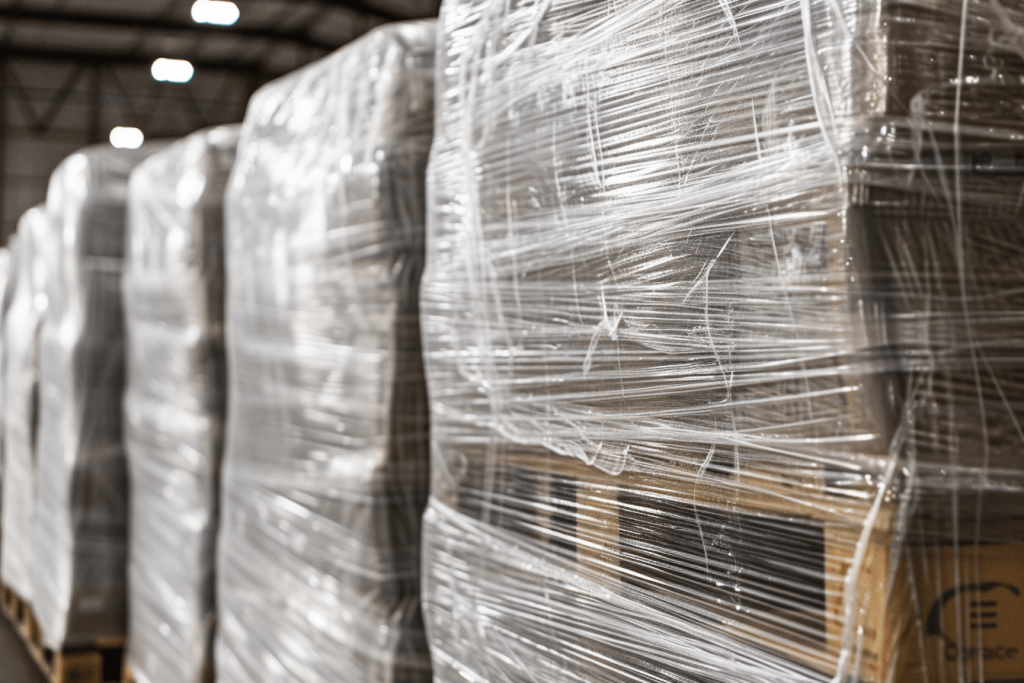
Factors to Consider in Film Selection
When choosing the right film for pallet packaging, it is essential to consider various factors to ensure that the selected film perfectly matches the specific needs of the packaging operation.
1. Load Type
The nature of the load, including its dimensions and fragility, plays an important role in choosing the right film. Different films offer varying levels of support and protection, and understanding the specific characteristics of the load is essential for making an informed choice. Whether it’s a delicate or irregularly shaped load, the film selection should provide the necessary stability and safeguarding.
2. Application System
The type of wrapping machine available—whether manual, semi-automatic, or automatic—directly influences the compatibility of the film. Each film type is designed with specific application systems in mind. Considering the capabilities and limitations of the wrapping machine ensures smooth integration and optimal performance.
3. Environmental Impact
Today, sustainability is a key consideration. Thus, evaluating the environmental impact of the chosen film is a must. Responsible packaging practices involve assessing the sustainability and energy efficiency of the film.
Some films, such as Stretch Hood, stand out for their reduced energy costs and material usage, contributing to environmentally conscious packaging solutions. Considering the long-term environmental impact that matches broader sustainability goals.
In a Nutshell
In industrial palletized load packaging, the selection of the right film is undoubtedly an important decision. Stretch Film, Shrink Wrap, and Stretch Hood each bring a unique set of advantages and applications to the table, catering to diverse industry needs.
As industries evolve, so do packaging requirements, and understanding the unique characteristics and benefits of these films ensures that businesses can make informed choices that match their specific needs.
Last but not least, the ongoing pursuit of sustainability adds another layer to the decision-making process, encouraging businesses to weigh environmental impacts and opt for eco-friendly solutions where possible. To find out more about Thong Guan’s LDPE shrink, click here.


